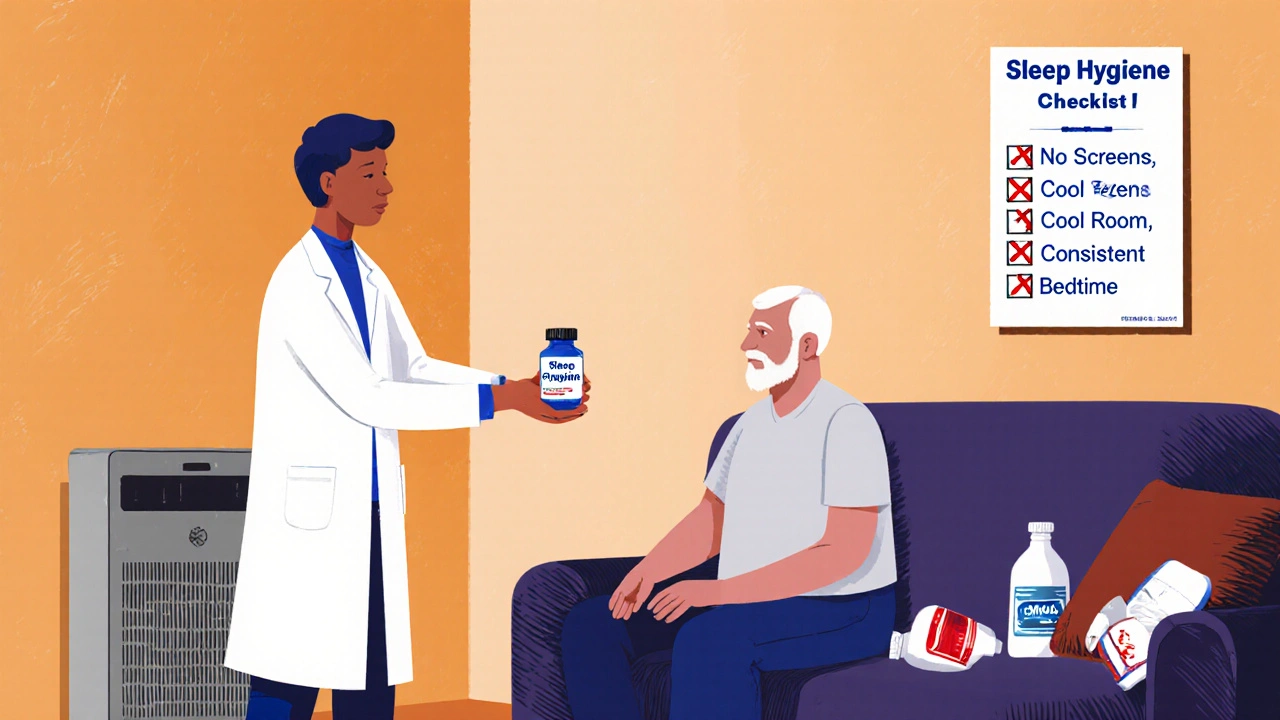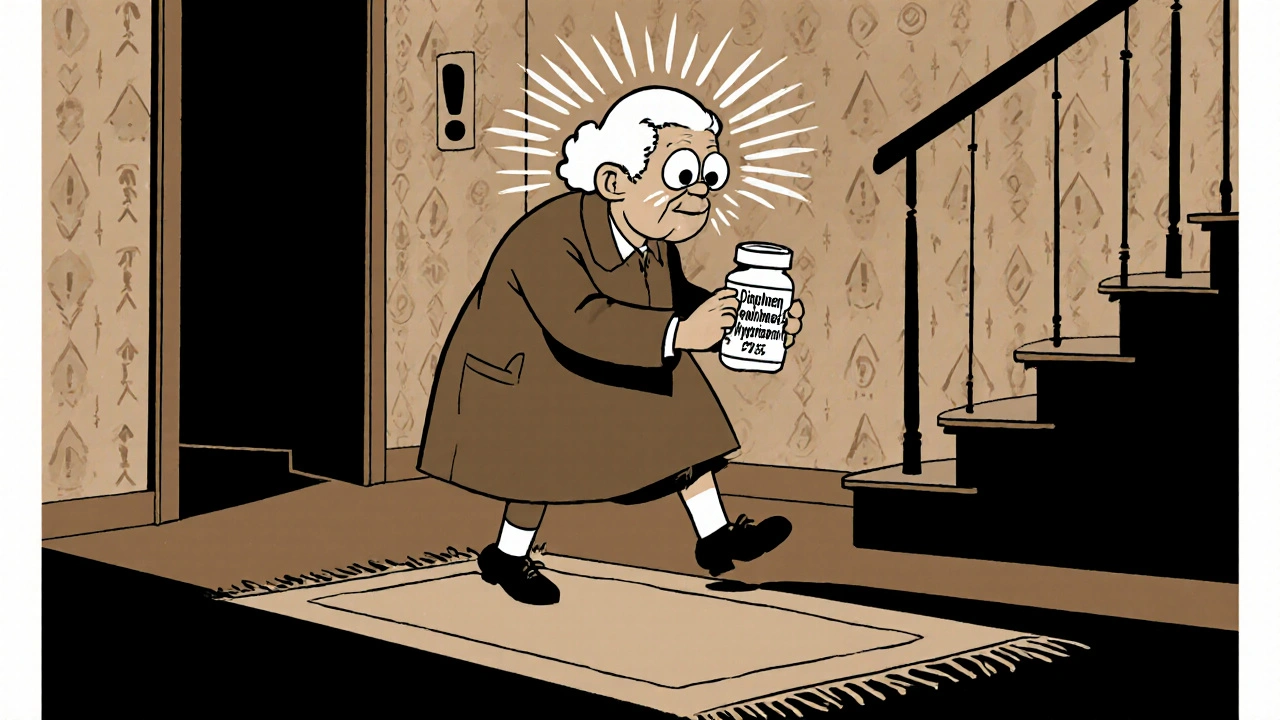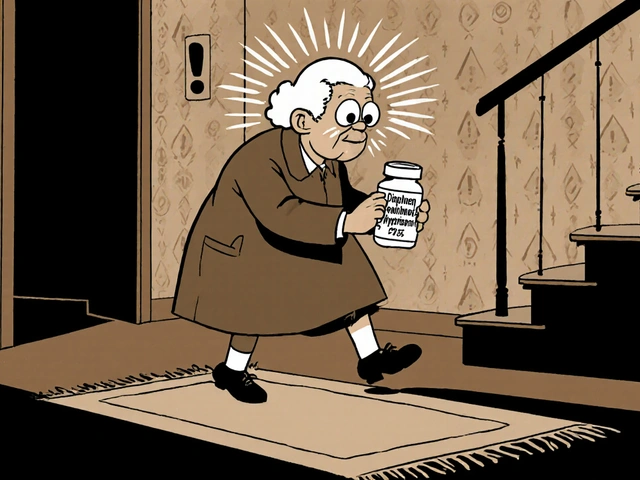Antihistamine Safety Checker
Check Your Antihistamine Safety
Enter an antihistamine name to determine if it's safe for older adults. Many common OTC medications contain sedating antihistamines that increase fall risk.
Why Sedating Antihistamines Are a Silent Threat to Older Adults
Every year, millions of older adults reach for over-the-counter allergy or sleep meds like Benadryl, thinking they’re harmless. But for people over 65, these common pills can be dangerous-sometimes deadly. The real problem isn’t just allergies or trouble sleeping. It’s the sedating antihistamines in those pills that slow down the brain, blur vision, and throw off balance. And when balance goes, falls follow. In fact, one in four older adults falls each year, and many of those falls are linked to medications they didn’t realize were risky.
First-generation antihistamines like diphenhydramine, chlorpheniramine, and brompheniramine are the main culprits. They work by blocking histamine to stop sneezing and itching, but they also slip easily into the brain. That’s why they make you drowsy. For a young person, that’s just a side effect. For an older adult, it’s a recipe for disaster. Their bodies process these drugs slower. The half-life of diphenhydramine jumps from 8.5 hours in young adults to 13.5 hours in seniors. That means drowsiness lasts longer, dizziness lingers, and reaction time slows down-right when you need it most.
How These Medications Increase Fall Risk
It’s not just about feeling sleepy. Sedating antihistamines cause a cluster of side effects that directly lead to falls: dizziness, blurred vision, dry mouth, confusion, and even low blood pressure when standing up. These aren’t minor inconveniences. They’re physical hazards. A 2018 meta-analysis in Osteoporosis International found that older adults taking first-generation antihistamines had a 54% higher risk of a serious fall or fracture. Another 2025 study tracking nearly 200,000 older patients showed that 8% of those who filled a prescription for these drugs fell and needed medical care within two months.
What makes this worse is that these medications are often taken without a doctor’s knowledge. Many seniors grab diphenhydramine from the shelf for sleep, allergies, or even nausea. They don’t see it as a drug-just a pill. But the American Geriatric Society classifies these as “potentially inappropriate” for older adults in their Beers Criteria, a trusted guide used by doctors nationwide. The reason? Strong anticholinergic effects. On the Anticholinergic Cognitive Burden Scale, first-generation antihistamines score 3 or 4 out of 4-meaning they significantly interfere with brain function. Compare that to second-generation options like fexofenadine or loratadine, which score 0 or 1. No red flags.
Second-Generation Antihistamines: The Safer Choice
If you need an antihistamine, you don’t have to choose risk. Second-generation options like cetirizine (Zyrtec), loratadine (Claritin), and fexofenadine (Allegra) were designed to stay out of the brain. They work just as well for allergies but with far less drowsiness. Studies show drowsiness affects only 6-14% of users with these drugs, compared to 15-20% with diphenhydramine. And crucially, they don’t raise fall risk. A 2025 study found no significant increase in falls among users of second-generation antihistamines, while first-generation ones boosted risk by 87%.
Still, not all second-generation options are equal. Cetirizine can still cause mild drowsiness in up to 14% of older adults. Fexofenadine, on the other hand, causes drowsiness in only 6%-making it the safest pick for seniors. Loratadine is also a solid option, especially at the standard 10mg daily dose. The key is avoiding anything labeled “PM,” “Nighttime,” or “Drowsiness Formula”-those almost always contain diphenhydramine or doxylamine, another high-risk sedating antihistamine.

What Doctors and Pharmacists Should Do
Healthcare providers need to stop treating older adults like younger patients. Just because a medication works for a 35-year-old doesn’t mean it’s safe for a 75-year-old. The CDC’s STEADI initiative gives clear guidance: STOP high-risk meds when possible, SWITCH to safer alternatives, and REDUCE doses to the lowest effective amount.
That means every annual wellness visit should include a full medication review. Not just prescriptions-over-the-counter drugs, herbal supplements, and even cough syrups. A 2023 study found that pharmacist-led “brown bag” reviews, where patients bring all their meds to the pharmacy, uncovered an average of 3.2 high-risk medications per senior. Many of those were sedating antihistamines.
When a senior is on diphenhydramine for sleep, don’t just take it away. Replace it with sleep hygiene: consistent bedtime, no caffeine after noon, dark and cool room, no screens before bed. For allergies, try nasal saline rinses-studies show they reduce symptoms by 35-40%. Use allergen-proof bedding to cut dust mites by 83%. Install HEPA filters to remove 99.97% of airborne allergens. These aren’t just alternatives-they’re often more effective and far safer.
Environmental Changes That Save Lives
Even if you switch to a safer medication, fall risk doesn’t disappear overnight. The body needs time to adjust. That’s why environmental changes matter just as much as medication changes. Simple fixes like adding grab bars in the bathroom can reduce falls by 28%. Improving lighting-especially on stairs and hallways-cuts falls by 32%. Removing loose rugs, extension cords, and clutter from walkways is one of the easiest and cheapest ways to prevent injury.
Many older adults don’t realize how much their home environment contributes to risk. A fall doesn’t always happen on a slick floor. It can happen reaching for a high shelf, stepping over a pet, or tripping on a threshold. A home safety check, even a quick one by a family member or home care worker, can make a huge difference.

Real-World Barriers and How to Overcome Them
Despite all the evidence, sedating antihistamines are still everywhere. In 2024, diphenhydramine was the third most bought OTC sleep aid in the U.S. among seniors-28.7 million units sold. That’s $142 million in sales. Why? Because labels are confusing. Packaging doesn’t scream “danger.” Many seniors don’t know the difference between first- and second-generation drugs. Pharmacists aren’t always asked to review OTC meds. And doctors sometimes default to prescribing what’s familiar.
Changing this requires action on multiple levels. Patients need to ask: “Is this the safest option for my age?” Pharmacists need to proactively offer medication reviews. Clinicians need to use the Beers Criteria as a checklist, not a footnote. And regulators need to require clearer warnings on OTC packaging-something the FDA started in 2020, but it’s still not enough.
There’s hope on the horizon. Two new antihistamines-AGS-2025-01 and FEX-AGE-101-are in Phase II trials. Early results show 89% less drowsiness than diphenhydramine. But we can’t wait for new drugs. We need to act now with what we have.
What Seniors and Families Can Do Today
Here’s what you can do right now:
- Check every medicine bottle in the house. Look for diphenhydramine, chlorpheniramine, or brompheniramine on the label.
- If you see them, don’t stop cold turkey-talk to your pharmacist or doctor first.
- Ask: “Is there a non-sedating alternative?” Fexofenadine, loratadine, or cetirizine are better choices.
- For sleep, try a consistent bedtime routine instead of a pill.
- For allergies, use saline rinses, HEPA filters, and allergen-proof covers.
- Walk through your home and remove tripping hazards. Add nightlights if needed.
It’s not about giving up comfort. It’s about choosing safety. A few minutes reviewing your meds could prevent a hospital stay, a broken hip, or worse. And it’s not just about the person taking the drug-it’s about the family who loves them and wants them to stay independent, mobile, and safe.
Are all antihistamines dangerous for older adults?
No. Only first-generation antihistamines like diphenhydramine, chlorpheniramine, and brompheniramine carry high fall risk because they cross into the brain and cause sedation. Second-generation antihistamines-such as fexofenadine (Allegra), loratadine (Claritin), and cetirizine (Zyrtec)-are much safer. Fexofenadine causes the least drowsiness and has no significant increase in fall risk for seniors.
Can I just lower the dose of diphenhydramine to make it safer?
Lowering the dose helps a little, but it doesn’t eliminate the risk. Even 12.5mg of diphenhydramine can still cause dizziness and impaired balance in older adults. The half-life is longer in seniors, so effects last longer. The safest approach is to switch to a non-sedating alternative entirely, not just reduce the dose.
Why do doctors still prescribe diphenhydramine to seniors?
Many doctors aren’t aware of the latest guidelines or assume the patient knows the risks. Others prescribe it because it’s cheap, familiar, or patients ask for it. Some use it for sleep because they don’t know about non-drug options. The American Geriatrics Society has warned against it since 2012, but prescribing habits change slowly. That’s why patient advocacy and pharmacist involvement are critical.
What should I do if my loved one is already taking diphenhydramine daily?
Don’t stop suddenly-this can cause rebound symptoms like severe itching or insomnia. Talk to a pharmacist or doctor about tapering the dose slowly while introducing a safer alternative. For sleep, start sleep hygiene practices. For allergies, try nasal rinses and HEPA filters. Schedule a medication review at the pharmacy. Many seniors feel better within a week of switching-no more morning fog, better balance, and more energy.
Are there any non-medication ways to manage allergies in seniors?
Yes. Nasal saline irrigation reduces allergy symptoms by 35-40%. Allergen-proof mattress and pillow covers reduce dust mite exposure by 83%. HEPA air purifiers remove 99.97% of airborne allergens. Keeping windows closed during high pollen seasons and showering before bed also helps. These methods work better than sedating pills for many seniors-and they don’t increase fall risk.
How often should older adults have their medications reviewed?
At least once a year during the Medicare Annual Wellness Visit, which now requires a fall risk and medication review. But if someone is taking multiple medications, has recently fallen, or has memory issues, a review every 6 months is recommended. Pharmacist-led reviews are especially effective-studies show they reduce fall risk by 26% in older adults.



Jennifer Walton
November 15, 2025 AT 02:23It’s not about fear. It’s about awareness.
Kihya Beitz
November 16, 2025 AT 18:52